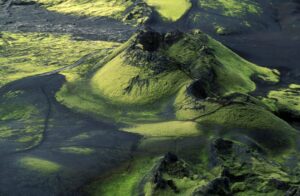This earthquake occurred on the boundary between the Pacific and North American tectonic plates at the Queen Charlotte Fault. Its magnitude was 8.1.
Canada’s largest earthquake of the past three hundred years, magnitude 8.1, occurred on August 22, 1949 off the coast of British Columbia on the Queen Charlotte Fault, the boundary between the Pacific and North American plates that runs underwater along the west coast of the Queen Charlotte Islands. The shaking was so severe that cows on the Queen Charlotte Islands were knocked off their feet.
A geologist working on the north end of Graham Island, the biggest island of the Queen Charlottes, could not stand up. Chimneys toppled, and an oil tank at an inlet collapsed. In Terrace, on the adjacent mainland, cars were bounced around. In Prince Rupert windows were shattered and buildings swayed. The earthquake was felt at Jasper, over six hundred miles away.
The fault rupture began in the ocean bottom offshore from Graham Island and spread for more than three hundred miles along the Queen Charlotte Fault. This fault extends from Vancouver Island to the Gulf of Alaska. It is a strike slip fault, similar to the San Andreas of California, and capable of generating equally large earthquakes. However, the Queen Charlotte Fault is offshore, whereas the San Andreas bisects major cities.
The Queen Charlottes are sparsely populated. There were no deaths from this earthquake but there were landslides and other damage. The offshore region of British Columbia is one of the highly active seismic regions of the world. In addition to the 1949 giant earthquake, there have been ten large earthquakes since 1872 with magnitudes between 6.7 and 7.9, all potentially very destructive. Fortunately, most of them occurred offshore or in remote regions so there were few deaths and only moderate damage.
The Juan de Fuca Plate is a completely different geological structure that separates the Queen Charlotte Fault from the San Andreas Fault. This plate extends from central Vancouver Island to southern Oregon. The Juan de Fuca Plate is a large part of the Pacific Ocean seabed which is slowly moving, driven by tectonic forces deep within the earth, and pushing under the coast of Oregon, Washington, and British Columbia.
Movement of the Juan de Fuca Plate is thought to have caused a super-giant earthquake on January 26 in the year 1700. Canadian, Japanese, and American scientists have found evidence in Indian legends, sea bottom sediment, and accounts of Japanese tsunamis that an earthquake occurred off western Vancouver Island with magnitude 9 or greater. Large sections of coast were drowned, Indian villages were lost, and a great sea wave or tsunami was observed hours later in Japan. Geological evidence shows that large earthquakes have in fact occurred repeatedly on the west coast in the past. Current observations of seismic activity and uplift of the coastal regions suggests that another super giant earthquake may be in the making.
The Queen Charlotte Fault, off western Canada and southeast Alaska, is a boundary between the Pacific and North American plates. Prior to the mid-1980s, very little was known about the detailed distribution of earthquakes in this area as there was no local seismograph network to detect and locate small earthquakes. Between 1982 and 1987, a network of twelve short period analogue seismographs was established on the Queen Charlotte Islands and the adjacent mainland; this network continued to operate until early 1996.
Analysis of earthquakes observed on these seismographs has revealed a more extensive earthquake pattern than that associated directly with the Queen Charlotte Fault. In particular, considerable seismicity occurs east of the fault, on Graham Island and in Hecate Strait, the ocean region between Graham Island and the Mainland of British Columbia.
Tectonically, both the Queen Charlotte region and California are dominated by a transform plate boundary between the Pacific and North American plates. In California the plates are moving at a relative rate of twenty-five miles per million years, mainly related to the San Andreas Fault. Off British Columbia’s coast the rate is thirty miles per million years, almost entirely carried by the Queen Charlotte Fault.
Geometry of the plate boundary in California has changed dramatically as two triple junctions migrated along the coast; the main transform fault has progressively moved inland over the years. The geometry of the Queen Charlotte Fault seems to have been fairly stable over tens of millions of years; triple junction complications have mostly been accommodated in oceanic crust to the south.





















